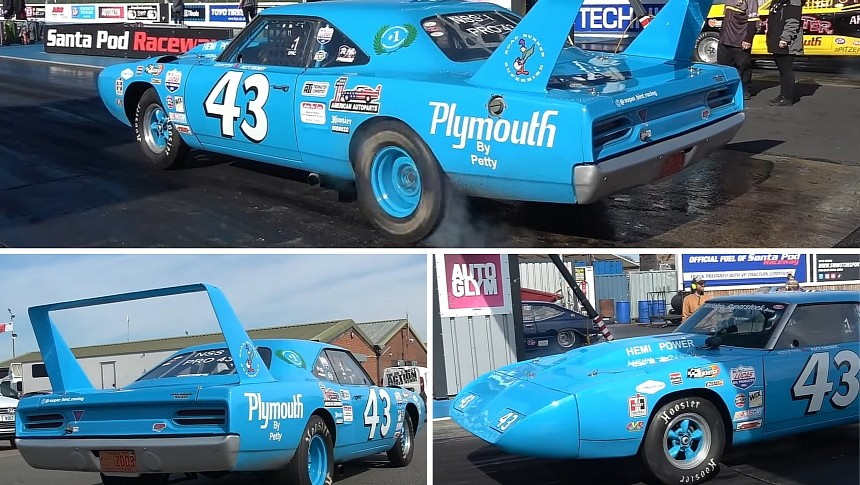Launched in 1970, about a year after its Dodge Charger Daytona counterpart, the Plymouth Superbird was created for two purposes. First, Plymouth also wanted a piece of the "winged warrior" action in NASCAR. Second, the company wanted to lure Richard Petty back into the team following his departure to Ford in the autumn of 1968.
Plymouth was required to build 500 road-legal cars to make the Superbird eligible for NASCAR but made more than 1,900 units. Things went according to plan, and Petty returned to race for Plymouth, but he finished only fourth in the drivers' standings. The title went to Bobby Isaac, who drove a Dodge Charger Daytona. 1970 was the last season for the aero cars as new NASCAR rules rendered them uncompetitive for 1971.
While he failed to win the series while driving the Superbird, the light blue, No. 43 "winged warrior" is among the most iconic Mopars driven by "The King." And the said Superbird inspired the creation of many tribute cars, usually based on the Road Runners. Most of them are road-going muscle cars that get paraded at local car shows, but the "Petty Blue" example you see here is a bit different. Because it rides on meaty rear tires, packs an oversized V8, and runs the quarter-mile faster than most modern muscle cars.
Yup, this "Petty Blue" Superbird may wear a livery that's identical to the car that Richard drove in 1970, but it wasn't built to take left turns on oval tracks. Instead, it's a rubber-burning straight-line monster that snaps off the line quicker than a factory-stock "winged warrior."
Spotted doing its thing at Santa Pod Raceway in Bedfordshire, England, this Superbird runs in the Pro ET class and packs a monstrous 572-cubic-inch (9.4-liter) V8 mill. It's unclear if it's a HEMI related to the original 426, but it's so massive that the hood needed a bulge to cover it entirely. And regardless of specs and layout, this V8 makes a lot of racket through the side-exiting exhaust pipes and sends the 'Bird down the quarter-mile quicker than any modern production muscle car but the insane Dodge Challenger SRT Demon 170.
Specifically, the footage shows the Superbird running a trio of sub-10-second runs. The first sprint sees the Mopar stopping the clock at 9.72 seconds and 133 mph (214 kph), but things get even quicker during the second run, clocked at 9.59 clicks and 139 mph (224 kph). The third attempt confirms that the Plymouth can be a mid-9-second regular at 9.59 hits and 136 mph (219 kph).
That's a tad quicker than the 2018 Dodge Challenger SRT Demon's official quarter-mile benchmark of 9.65 seconds and about a half-second slower than the 2023 SRT Demon 170. The latter was clocked at 8.91 seconds. That's mighty impressive for a Superbird, regardless of what's under the skin.
Even though this Mopar is most likely a modified Road Runner, some Superbirds were converted for drag-strip duty back in the day. One even went as far as to win the Super Stock class of the 1970 NHRA Summernationals with a Sox & Martin V8 under the hood and Tim Richards behind the steering wheel. Finished in a psychedelic livery and awaiting to be reunited with its original engine, the car resides in the Jennings Wing Cars collection.
While he failed to win the series while driving the Superbird, the light blue, No. 43 "winged warrior" is among the most iconic Mopars driven by "The King." And the said Superbird inspired the creation of many tribute cars, usually based on the Road Runners. Most of them are road-going muscle cars that get paraded at local car shows, but the "Petty Blue" example you see here is a bit different. Because it rides on meaty rear tires, packs an oversized V8, and runs the quarter-mile faster than most modern muscle cars.
Yup, this "Petty Blue" Superbird may wear a livery that's identical to the car that Richard drove in 1970, but it wasn't built to take left turns on oval tracks. Instead, it's a rubber-burning straight-line monster that snaps off the line quicker than a factory-stock "winged warrior."
Spotted doing its thing at Santa Pod Raceway in Bedfordshire, England, this Superbird runs in the Pro ET class and packs a monstrous 572-cubic-inch (9.4-liter) V8 mill. It's unclear if it's a HEMI related to the original 426, but it's so massive that the hood needed a bulge to cover it entirely. And regardless of specs and layout, this V8 makes a lot of racket through the side-exiting exhaust pipes and sends the 'Bird down the quarter-mile quicker than any modern production muscle car but the insane Dodge Challenger SRT Demon 170.
Specifically, the footage shows the Superbird running a trio of sub-10-second runs. The first sprint sees the Mopar stopping the clock at 9.72 seconds and 133 mph (214 kph), but things get even quicker during the second run, clocked at 9.59 clicks and 139 mph (224 kph). The third attempt confirms that the Plymouth can be a mid-9-second regular at 9.59 hits and 136 mph (219 kph).
That's a tad quicker than the 2018 Dodge Challenger SRT Demon's official quarter-mile benchmark of 9.65 seconds and about a half-second slower than the 2023 SRT Demon 170. The latter was clocked at 8.91 seconds. That's mighty impressive for a Superbird, regardless of what's under the skin.
Even though this Mopar is most likely a modified Road Runner, some Superbirds were converted for drag-strip duty back in the day. One even went as far as to win the Super Stock class of the 1970 NHRA Summernationals with a Sox & Martin V8 under the hood and Tim Richards behind the steering wheel. Finished in a psychedelic livery and awaiting to be reunited with its original engine, the car resides in the Jennings Wing Cars collection.









